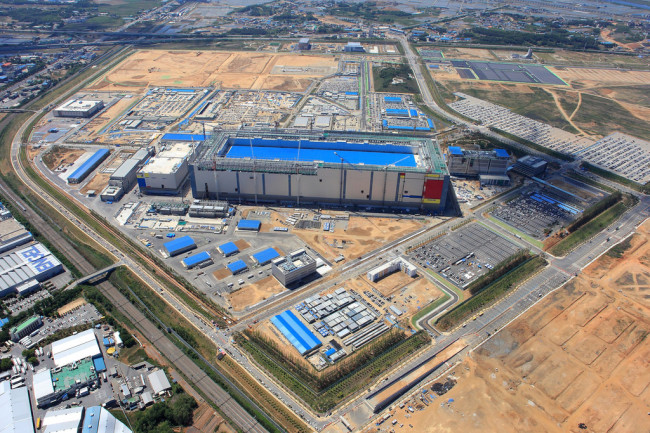 |
Samsung's first memory fab in Pyeongtaek (Samsung Electronics) |
Samsung Electronics appears to be gearing up for the operation of its second memory plant in Pyeongtaek, Gyeonggi Province, in March next year, in a move seen to maintain its leadership despite unfavorable market circumstances, according to industry sources and news reports Sunday.
The tech giant has reportedly held meetings with entities involved with the Pyeongtaek project including the municipal office of the city to discuss the supply of public utilities for the new factory by fixing the schedule of its operation in March 2020.
The operation of the new plant, valued at 30 trillion won ($26.4 billion), was widely expected by industry watchers to begin in June of 2020. But the plan seems to be have been moved forward to March despite current slow market conditions. The chipmaker might be moving more quickly in preparation of a market recovery next year so that it can take an advantageous position in terms of pricing when demand goes up.
“Samsung seems to be preparing for recovery of demand for memory chips next year,” said an industry official. “And the new fab will be used probably for the most high-tech DRAM chips that will go into high-spec digital devices like foldable smartphones.”
The world’s top memory chip provider broke ground for the second fabrication facility for memory chips next to its first plant that is already the single largest memory fab in the world.
The entire Samsung memory complex in Pyeongtaek measures in at 2.89 million square meters, about the size of 400 football stadiums.
Samsung is planning to build two more memory fabs within the complex, and plans for the next construction are also likely to be announced soon.
Last week, the company reached an agreement with residents of nearby cities spanning from West Anseong to Godeok to build electricity pylons that will provide up to 2000 megawatts of power for the semiconductor production facilities.
The construction of the towers was strongly objected residents who had claimed that such high voltage transmission towers could pose a threat to their health.
“Although prices of DRAM and NAND flash chips experienced fall in the first quarter, Samsung didn’t scale down its investment plans,” the official said. “Senior company officials are predicting the demand will pick up in the second half of this year and continue to rise rapidly next year.”
“The upcoming memory plant will play a key role in striking a balance between supply and demand, and Samsung will be wanting to take the lead,” he added.
According to Samsung, it had initially set a rough timeline for the new fab to begin operations in March next year, a Samsung public relations official said, which had not been made public until recently.
“It’s not been officially announced because the schedule could be adjusted in accordance with market conditions,” the official said. “The timetable was set early last year when the company broke ground for the second plant, but the market is now totally different.”
By Song Su-hyun (
song@heraldcorp.com)








